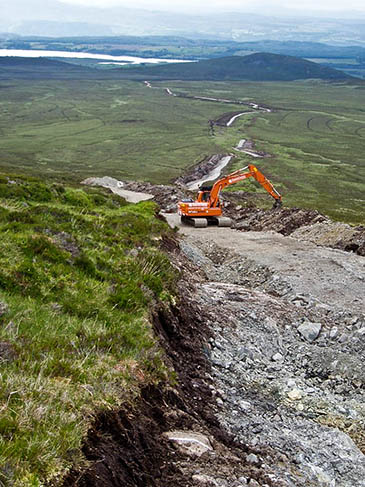Mountaineers have warned that delays in implementing new rules on hilltracks in Scotland could lead to a rush by landowners to beat the deadline.
The Mountaineering Council of Scotland said it was disappointed there would not be an immediate moratorium on building new tracks on the nation’s mountains.
The Scottish Government today announced new planning controls on the building of access tracks. The MCofS has been vocal in its campaign to stop the unfettered building of the tracks, which is said scar many hillsides.
Planning authorities will be able to consider how proposed tracks will affect the environment and ‘intervene to ensure that design, siting and appearance are acceptable.
But the Government announcement said the requirements will be introduced across the country later in the year.
MCofS chief officer David Gibson said: “The present government has presided over and, in many cases, approved developments, leading to an unprecedented reduction in wild land across Scotland, so we naturally welcome the introduction of measures by them which we hope will mitigate further damage to Scotland’s landscape caused by bulldozed tracks.
“We look forward to seeing the detail about the planning controls and being able to confirm that there will be real protection for the landscape from hilltracks.
“We would have expected an immediate moratorium on building tracks without permission, because experience has already shown that such delay only creates a window of opportunity during which more damage can be done.”
Historically, agricultural and forestry tracks could be constructed and upgraded under permitted development rights, meaning that provided they met certain criteria a planning application was not required.
Local government and planning minister Derek Mackay said: “Without proper controls and effective enforcement measures, the construction of hilltracks can damage our environment.
“Some hilltracks can undercut the hillside and lead to side banks collapsing and hilltracks can cause damage to wild animal habitat.
“In contrast, well-constructed tracks can minimise negative impacts on the environment, and in the moorlands can often prevent damage to ground nesting birds and their eggs.
“That’s why it’s important that planning policy strikes the right balance between meeting the needs of rural businesses but also it protects Scotland’s environment, amenity and heritage.
“These new controls will ask planning authorities to weigh up proposals and consider all aspects of where the hilltracks will be built, while at the same time allowing work that does not have an adverse impact to proceed with minimal delay or costs.”
The Scottish Government said it had consulted Scottish Environment Link, Ramblers Scotland, Mountaineering Society of Scotland [sic], Scottish Land and Estates, National Farmers Union, ConFor, Scottish Natural Heritage, Forestry Commission Scotland, national park authorities, the Convention of Scottish Local Authorities and heads of planning.
